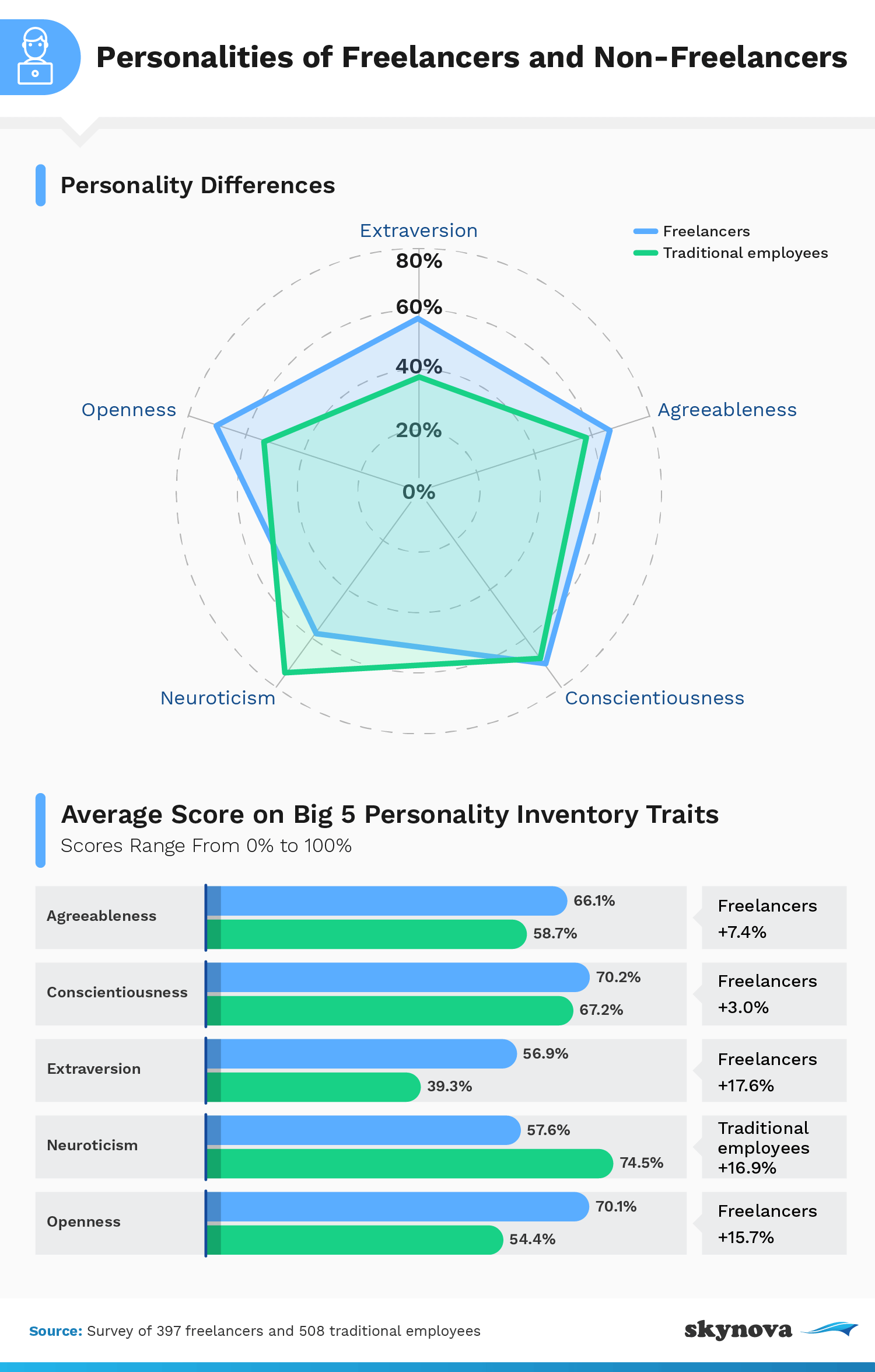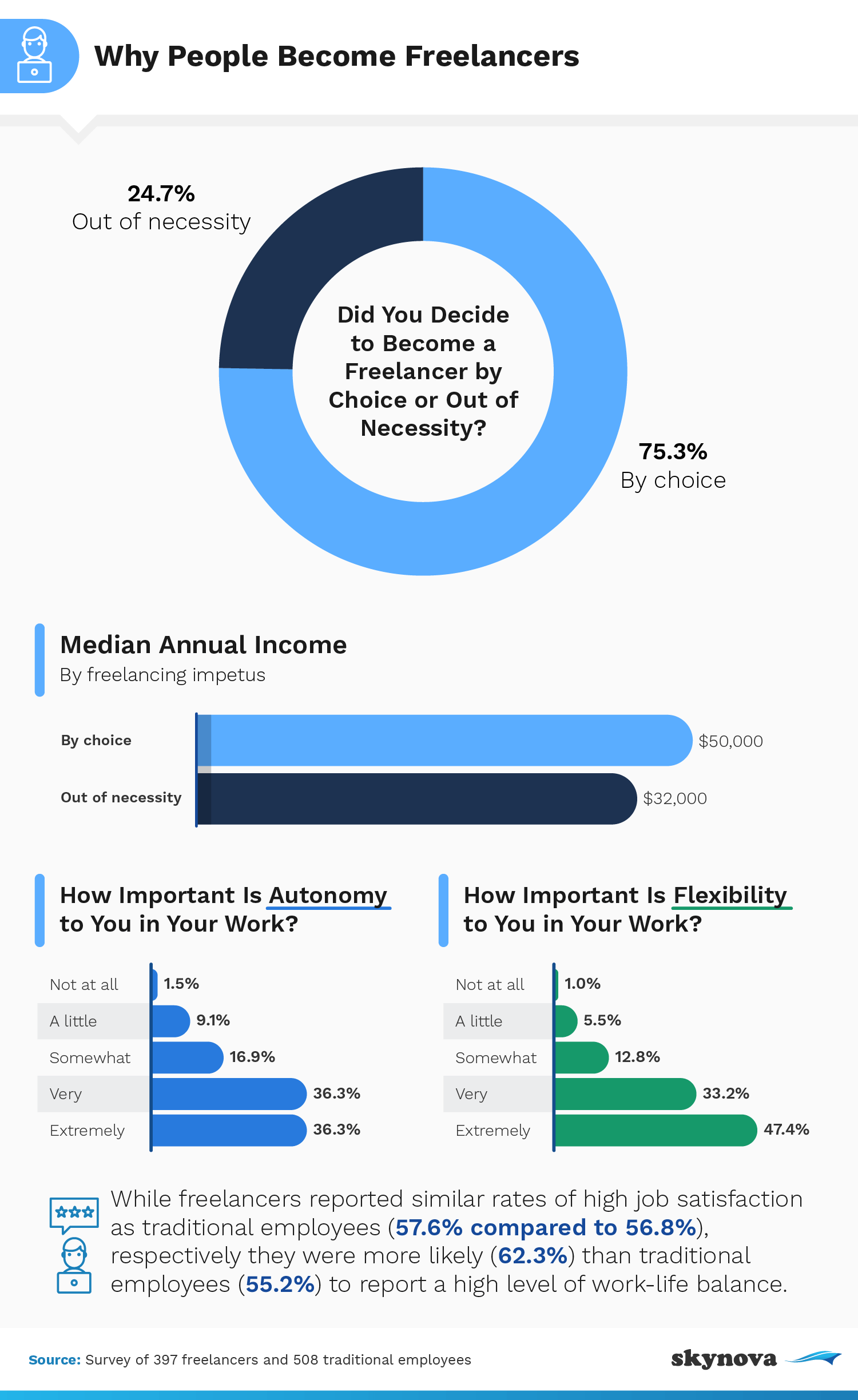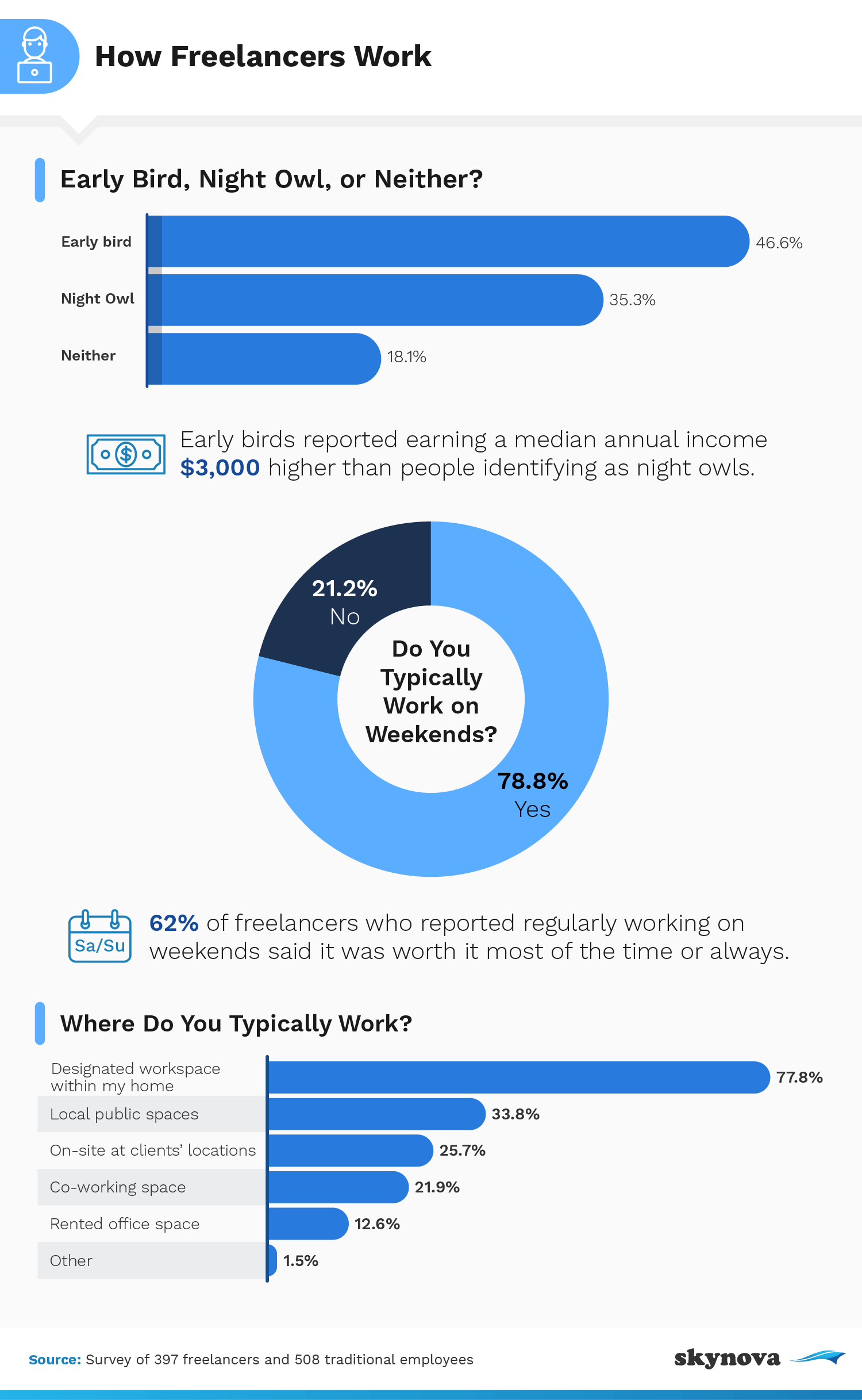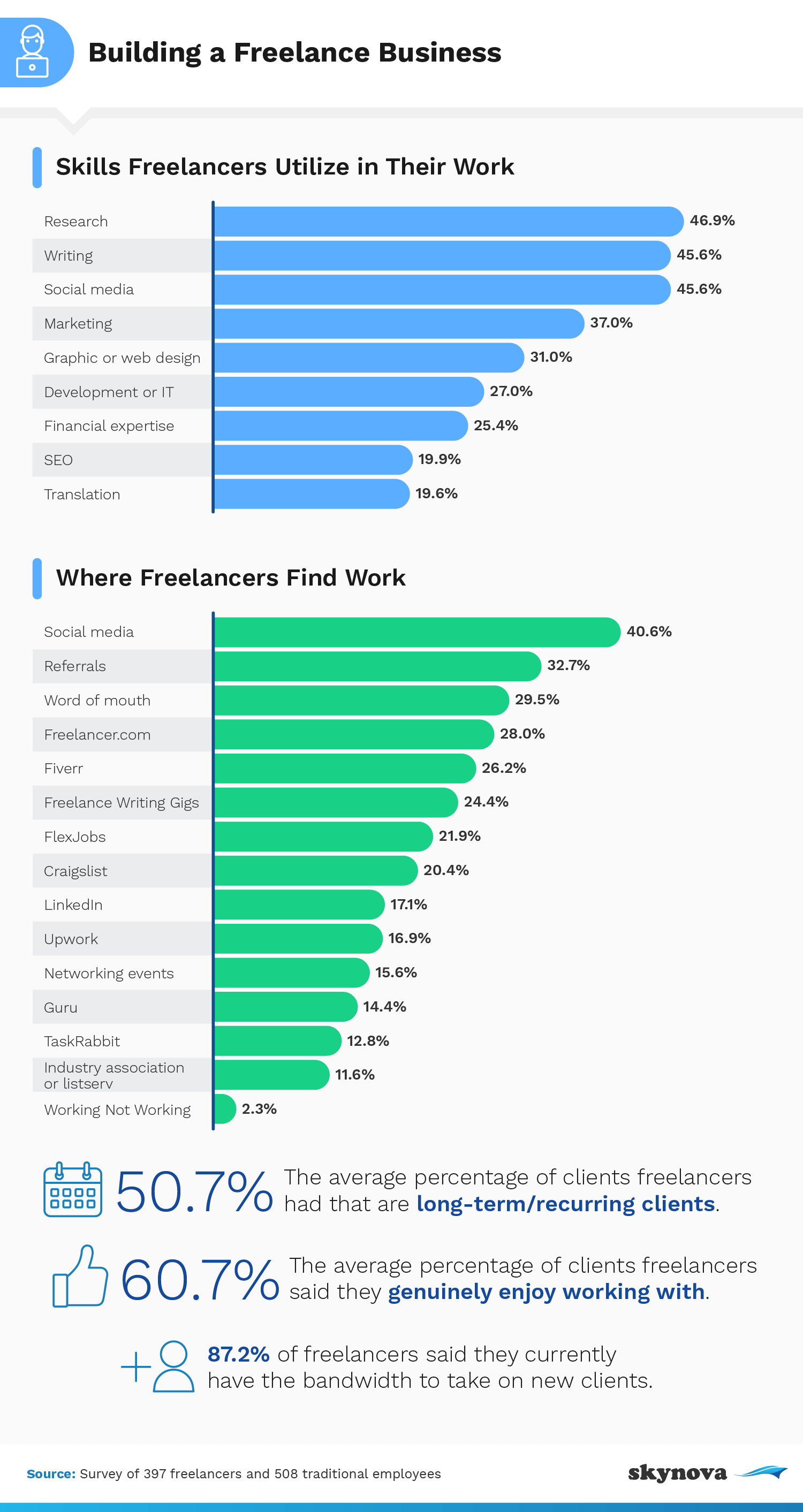
|
Some kids dream of becoming firefighters, others doctors, and there's always some aspiring lawyers among them. While becoming a freelancer probably isn't an aspiration that children have, it does become an attractive option when it's time to enter the working world. We've surveyed 397 freelancers and 508 traditional employees to compare and contrast their work lives and later focused more on what it takes to become a successful freelancer.
How did respondents fare on the Big Five Personality Test – were there any discernible differences between freelancers and traditional employees? For those going the freelance route, what inspired them to take that leap? What do their work schedules look like, and what skills are they trying to perfect to separate themselves from the pack? Read on to learn more about the ins and outs of the freelance lifestyle.
When comparing the Big Five Personality traits of freelancers and traditional employees, some key differences can be noted.

According to the test results, freelance workers were a lot more extroverted and open than traditional workers were. While different personality types can thrive in the workplace in their own distinct ways, extroverts do hold certain advantages over introverts. For example, they tend to stay more positive compared to their quieter counterparts, helping combat burnout and work-life imbalance. Also, extroverts tend to excel in both verbal and nonverbal communication, which can be key for freelancers who are constantly looking to secure new clients and build relationships with existing ones.
On the other hand, traditional workers exhibited much higher levels of neuroticism than freelancers, and it is the only trait of the Big Five that is associated with negative behavioral characteristics. Neurotics are sensitive to environmental stimuli and will often overstress about instances throughout their day, like replaying a conversation over in their head or worrying if the email they just sent was perfect. As a result, they tend to lose concentration, impeding even more on their jobs. That being said, research has shown that moderate levels of neuroticism can actually be beneficial in the workplace. For example, these neurotics might be able to better identify threats in the workplace, minimize risk, assume more personal responsibility, and exceed the expectations of their supervisors.
According to an analysis from Statista, the number of freelancers is expected to rise to more than 50% of the total U.S. workforce by 2027. So, what's driving this shift from the traditional employee to the self-employed freelancer?

Over three-quarters of people put the 'free' in freelancer, as it was their decision to pursue that particular career path. The median income of people who chose to freelance was $50,000 per year, but the other quarter that did it out of necessity were only making $32,000 annually.
Preference or not, freelancers agreed that both autonomy and flexibility were of utmost importance to them. By working for yourself, you get complete control of the clients you want to work with and the kinds of projects you are willing to take on. It allows for immense flexibility of location – as long as a job is well done and on time, a contractor won't care where it gets done.
Both freelancers and traditional workers reported similar levels of job satisfaction, but the former had noticeably higher levels of work-life balance. Due to the previously mentioned factor of location independence, as well as the ability to create their own schedule and prioritize needs how they see fit, freelancers tend to have an easier time achieving a balance that works for them.
Freelancers enjoy much more flexibility than traditional employees when it comes to when and where they work.

Nearly 47% of freelancers identified as early birds, whereas 35.3% were night owls, and the rest were somewhere in between. Those who liked getting up early also made a median annual income of $3,000 more than people staying up late into the night. In the morning, we tend to have more energy, allowing us to think more creatively and use our time productively. Early risers also get to take advantage of the 'morning calm,' before the regular workday kicks in and email inboxes begin to get flooded, allowing them to focus better on their tasks at hand. These may be a couple reasons why early bird freelancers make slightly more money than their late-night counterparts.
The majority of freelancers also said they typically worked on weekends, and well over half said it was worth doing so. Like early mornings, the weekend offers more peace and quiet, as most people are out of the office – this can allow freelancers to get their work done without the usual hustle-and-bustle of a standard workday.
Regarding their typical work setups, over three-quarters of respondents tended to set up shop at a designated workspace in their home, whereas a third preferred to go to a local public space, just over a quarter went to a client's location, and more than a fifth opted for a co-working space. The rest rented their own office space or found a different avenue that worked for them.
To separate themselves from the pack, freelancers take it upon themselves to master a variety of skills.

Of these skills, research, writing, and social media were the top three for which they focused on becoming experts. Let's outline why mastering writing, for example, can be beneficial for an aspiring freelancer. The skill itself can be applied to a number of different jobs, including blog writing, copywriting, editing, and proofreading. As companies continue to transition to online landscapes, the need for all aspects of online content creation are at an all-time high – becoming proficient in writing can open the door for many different opportunities.
When looking for work, freelancers reported the most luck on social media platforms. Some platforms, like LinkedIn, are dedicated exclusively for networking purposes, so looking there first is a good idea. That being said, companies use major platforms like Facebook and Twitter to let the world know that they're looking to onboard new workers. Considering 3.96 billion people use social media, countless people are constantly coming across job postings and application processes, and many are getting new clients because of it!
Over half of freelancers' clients were long-term work partners, and they liked doing business with about 60% of them. More than 80% said they're ready to take on more work, too.
Upon taking the Big Five Personality Test, freelancers were more extroverted and open than traditional workers, who displayed higher levels of neuroticism. Freelancers are always on the hunt for new leads and clients, making open communication and lots of networking a vital aspect of their job. Meanwhile, moderate neuroticism can actually be beneficial in a workplace setting, but can become detrimental at high levels.
The two most attractive aspects of freelance work were deemed to be autonomy and flexibility. Freelancers work for who they want and where they want, which is a huge perk for many. A lot tended to work weekends too and didn't really mind – a more relaxed work environment presents itself when a significant portion of the world is out of the office. Lastly, freelancers primarily focused on mastering their researching, writing, and social media skills. All three positions can complement one another, and companies are always on the lookout for new talent in these fields. If you've ever considered becoming a freelancer, what better time to start than now?
For all of a small business' online invoicing needs, Skynova's modules bring a heightened sense of organization and efficiency to their processes. We also like to write different articles pertaining to subjects that we hope you enjoy reading about. They usually take on a business or workplace angle, in this case, a deep dive into the world of freelancing.
We surveyed 397 freelancers and 508 traditional employees to analyze the personality differences between these two sets of workers. Freelancer respondents were 58% men, 41% women, and 1% nonbinary. The average age of freelancer respondents was 38.3. Traditional employee respondents were 53.8% men and 45.8% women. Two respondents were nonbinary. The average age of traditional employee respondents was 36.9.
We used the abbreviated Big Five Inventory to measure the agreeableness, extraversion, conscientiousness, neuroticism, and openness of all respondents. Scores on each variable were out of 10. In our final visualization of the data, scores were multiplied by 10 to be out of 100.
The data we are presenting rely on self-report. There are many issues with self-reported data. These issues include, but are not limited to, the following: selective memory, telescoping, attribution, and exaggeration.
If you're a freelancer or you've ever considered going down that career path, we hope you've enjoyed reading about our findings. We encourage you to share this article with your friends and family, but just ask that you do so for noncommercial use only. Also, if shared, please provide a link back to the article page for full access to our research and methodologies.